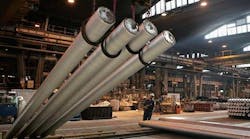Commodity companies are beginning to feel the impact of President Donald Trump’s trade policies, and their earnings report cards will signal how well they’ve been able to protect shareholder value.
Raw-material producers are coming off their worst week since February following the longest quarterly sell-off in commodities since 2015. Demand concerns mounted after the International Monetary Fund cut its global growth forecast, in part due to escalating trade tensions. Amid the tumult, energy markets have been a rare bright spot, with both oil and natural gas reaching multi-year highs in 2018.
Industrial-metal miners are bearing the brunt of the tariffs, with Alcoa Corp. forecast to post its weakest quarterly earnings since it split from its jet- and car-parts business in late 2016. In agriculture, producers still face low prices but a volatility pickup may help traders.
While higher steel prices-- a consequence of metal levies-- boosted costs for some oil companies, these are no match for the strong tailwind from the rally in crude.
"There’s a dichotomy in performance between the metals and the energy side,” said Peter Sorrentino, the Dallas-based chief investment officer of Comerica Asset Management Group, which oversees $67 billion. “Industrial metals and even precious metals, for the most part, have been under pressure from a strong dollar, and most of the energy components have done better, from crude oil to even natural gas."
Metal Miners
The Bloomberg World Mining Index has tumbled 12% since the end of June as prices of many raw materials tumbled. A gauge of industrial metals including copper and aluminum slipped 0.2% on Oct. 16, taking this year’s slump to 14%. Apart from the pain of lower cash flow, miners also faced higher cost that came with the surge in crude oil prices.
Signs of economic slowdown in China are raising demand concerns for the world’s largest consumer of metals, grains and energy. An index of new export orders that the Chinese government published earlier this month fell. A Bloomberg Economics gauge that aggregates the earliest-available indicators on business conditions and market sentiment signaled the nation’s growth decelerated in September, even before the latest round of tariffs took effect.
“Weaker commodity prices are expected to weigh on earnings,” RBC Capital Markets analysts including Stephen Walker said in a note last week. The analysts remain “cautious as China decelerates,” even as they acknowledged that a rebound in infrastructure spending could lift metal prices by mid-2019.
While Trump’s metal tariffs were intended to protect U.S. companies, Alcoa, the nation’s largest aluminum producer, also took a hit as the levies boosted costs of shipping raw material into the country from its smelters in Canada. The company may confirm analysts’ expectations of a rebound in earnings in the fourth quarter when it reports third-quarter financial results on Wednesday.
Agriculture
If agricultural commodity giant Cargill Inc. is any gauge, the worst may be over at the trading desks of other firms such as Bunge Ltd. and Archer-Daniels-Midland Co.
Last month, closely held Cargill said its trading earnings rose “appreciably” in the three months through August. That’s after years of low volatility curbed trading opportunities and prompted Cargill and its peers to diversify into other areas.
A drought in Argentina this year slashed soybean crops and a scorching summer hurt Europe’s wheat harvest. The trade war is adding to market swings that are bringing trading back to life -- at least for Cargill. Results from its other segments fell.
In the case of Deere & Co., the impact from the trade war may not show up until 2019. The world’s largest tractor manufacturer is expected to post strong sales as more farmers replace old equipment.
Oil Producers
Even before crude’s run above $80 a barrel at the end of the third quarter, Big Oil was already churning out cash at the highest level since at least 2010, according to Rystad Energy. The question investors and analysts are asking when the companies report earnings is what they will do with all that money.
For Exxon Mobil Corp., the answer is simple: undertake big capital-intensive projects from Brazil to Mozambique that will help rebuild its portfolio of upstream assets that have caused production to stagnate of late. Investors will be watching for any signs there will be enough left over for share buybacks.
For Chevron Corp., it’s a bit more complicated. The U.S. oil major introduced a modest buyback program last quarter but may be in a position to extend it this time around. Investors will be watching to see if the company can quantify cost overruns at its giant Tengiz project in Kazakhstan and whether they will affect its capital budget for the year.
“The integrated companies in the oil sector seem to be the best positioned to more dynamically manage their cash flow,” said Terence Brennan, a commodities fund manager at Lazard Asset Management, which oversees $214 billion. “The one obstacle for returning cash to shareholders through dividends and buybacks however, is that the companies may actually have to begin investing in their business again as the pipeline of projects drops of significantly over the next two years.”
By Marvin G. Perez and Kevin Crowley



